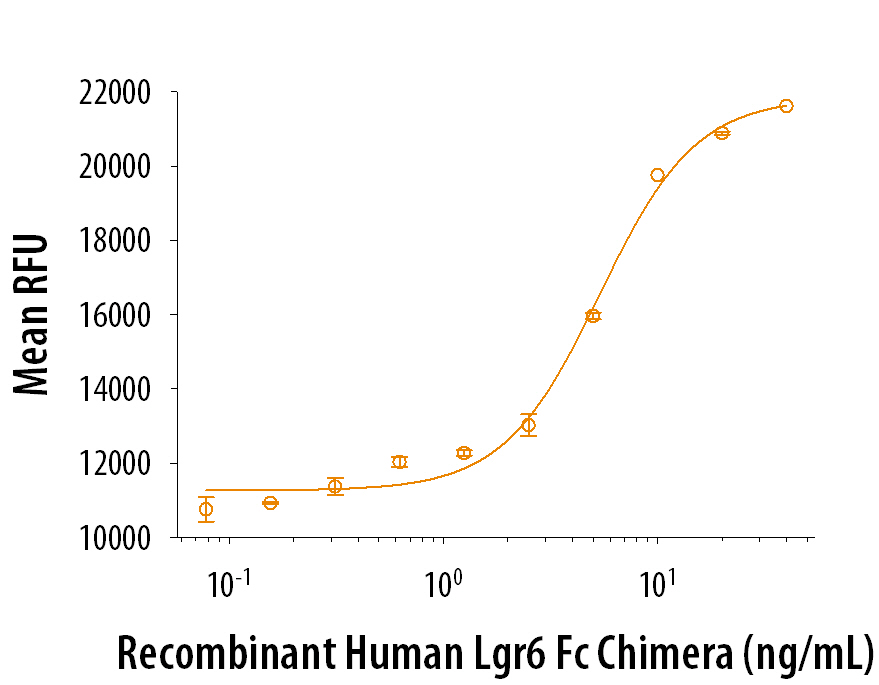Recombinant Human Lgr6 Fc Chimera Protein, CF Summary
Product Specifications
| Human Lgr6 (Ala25-Ala567) Accession # Q9HBX8 |
IEGRMD | Human IgG1 (Pro100-Lys330) |
| N-terminus | C-terminus | |
Analysis
Product Datasheets
Carrier Free
CF stands for Carrier Free (CF). We typically add Bovine Serum Albumin (BSA) as a carrier protein to our recombinant proteins. Adding a carrier protein enhances protein stability, increases shelf-life, and allows the recombinant protein to be stored at a more dilute concentration. The carrier free version does not contain BSA.
In general, we advise purchasing the recombinant protein with BSA for use in cell or tissue culture, or as an ELISA standard. In contrast, the carrier free protein is recommended for applications, in which the presence of BSA could interfere.
8470-GP
| Formulation | Lyophilized from a 0.2 μm filtered solution in PBS. |
| Reconstitution | Reconstitute at 100 μg/mL in PBS. |
| Shipping | The product is shipped at ambient temperature. Upon receipt, store it immediately at the temperature recommended below. |
| Stability & Storage: | Use a manual defrost freezer and avoid repeated freeze-thaw cycles.
|
Scientific Data
 View Larger
View Larger
Recombinant Human Lgr6 induces Topflash reporter activity in HEK293T human embryonic kidney cells. The ED50 for this effect is 2.5-12.5 µg/mL in the presence of 10 ng/mL Recombinant Mouse Wnt-3a (Catalog # 1324-WN).
Reconstitution Calculator
Background: Lgr6
Lgr6 (leucine‑rich repeat G protein‑coupled receptor 6) is an approximately 100 kDa 7‑transmembrane glycoprotein in the Lgr family of cell surface receptors. Lgrs has been identified as a marker for specific types of stem cells in tissues that are subject to constant self-renewal such as skin, gastrointestinal tract, and lungs (1, 2). The 544 amino acid (aa) N-terminal extracellular domain (ECD) of mature human Lgr6 contains 15 LRRs flanked by N-terminal and C-and C-terminal LRR domains. The ECD is followed by a 7-TM region and a 137 aa C-terminal cytoplasmic domain (3). Within the N-terminal ECD, human Lgr6 shares 92% and 93% aa sequence identity with mouse and rat Lgr6, respectively. Alternative splicing generates an additional isoform with a substitution for the LRR N-terminal domain and a deletion of LRR3-6. Lgr6 is expressed on hair follicle stem cells that give rise to sebaceous glands, interfollicular epidermis, and hair follicles (4-6). It is also expressed on alveolar stem cells that differentiate into lung epithelium (7). It is often up-regulated in human gastric cancers (8). Lgr6 binds to R‑Spondins 1-4 and can enhance Wnt/beta-Catenin signaling through phosphorylation of the Wnt co-receptor LRP6 (9, 10).
- de Lau, W. et al. (2014) Genes Dev. 28:305.
- Leushacke, M. and N. Barker (2012) Oncogene 31:3009.
- Hsu, S.Y. et al. (2000) Mol. Endocrinol. 14:1257.
- Snippert, H.J. et al. (2010) Science 327:1385.
- Liao, X.-H. and H. Nguyen (2014) Exp. Dermatol. 23:195.
- Nath, M. et al. (2011) Cell Tissue Res. 344:435.
- Oeztuerk-Winder, F. et al. (2012) EMBO J. 31:3431.
- Steffen, J.S. et al. (2012) Virchows Arch. 461:355.
- Gong, X. et al. (2012) PLoS ONE 7:e37137.
- de Lau, W. et al. (2011) Nature 476:293.
FAQs
No product specific FAQs exist for this product, however you may
View all Proteins and Enzyme FAQsReviews for Recombinant Human Lgr6 Fc Chimera Protein, CF
There are currently no reviews for this product. Be the first to review Recombinant Human Lgr6 Fc Chimera Protein, CF and earn rewards!
Have you used Recombinant Human Lgr6 Fc Chimera Protein, CF?
Submit a review and receive an Amazon gift card.
$25/€18/£15/$25CAN/¥75 Yuan/¥2500 Yen for a review with an image
$10/€7/£6/$10 CAD/¥70 Yuan/¥1110 Yen for a review without an image

